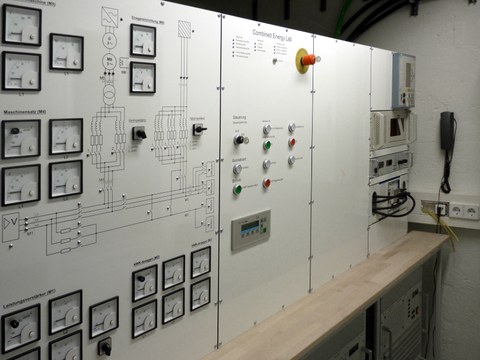Labore der Professur
Inhaltsverzeichnis
Dynamisches Netzmodell
Das Dynamische Netzmodell ist eine realitätsgetreue Nachbildung einer 220kV-Freileitung mit zwei Systemen und 150km Leitungslänge.
Das Dynamische Netzmodell arbeitet mit Modellspannungen und -strömen (mU = 1/500, mI = 1/20) bei einer Netzfrequenz von 50Hz. Die Kopplung beider Freileitungssysteme geschieht durch Luftspulen und Kondensatoren. Zwei rotierende Umformer stellen die Kraftwerke im Netz dar und diverse R-L-C-Bänke die Belastung und Abnehmer des Modellnetzes. Das Modell ist mit moderner Schutz- und Leittechnik ausgestattet.
Verwendung
Das Dynamische Modell wird hauptsächlich in der Lehre verwendet. Hier liegt der Schwerpunkt bei:
- Identifikation von Leitungsparametern
- Stations- und Netzleittechnik
- Distanzschutz und Staffelung von Schutzsystemen
Combined Energy Lab
Das Combined Energy Lab ist aus der Motivation heraus entstanden, vollumfängliche Untersuchungen von Wärmeerzeugern sowohl aus thermischer als auch aus elektrischer Sicht zu ermöglichen. Dies wird durch zwei getrennt operierende Netzemulatoren, dem Gebäude- und Niederspannungsnetzemulator, realisiert. Aus Sicht der Wärmeerzeuger wirken diese Emulatoren wie reale Netze. In diesem Zusammenhang spricht man von Hardware-in-the-Loop (HIL) Tests.
Beide Emulatoren haben gemein, dass sie aus einer hardware- sowie einer softwaretechnischen Komponente bestehen. Der Gebäudeemulator ist dabei auf Seiten der Hardware durch eine variable hydraulische Schaltung mit der Möglichkeit, verschiedene Wärmespeicher einzubinden und hydraulische Verschaltungen zu realisieren, gekennzeichnet. Durch eine überlagerte, auf einem 3D-Gebäudemodell basierende Simulation wird in Abhängigkeit des aktuellen Betriebszustands des Wärmeerzeugers sowie des aktuellen Wärmebedarfs im simulierten Gebäude die Sollrücklauftemperatur sowie der Volumenstrom ermittelt und mittels geeigneter Stellglieder in den Hardwarekomponenten vorgegeben. Hierdurch ist das komplette Heizsystem einer beliebigen Liegenschaft sowie beliebige Gebäude mit den Parametern z.B. Wärmedämmstandard oder Geometrie emulierbar. An den Emulationsversuchsstand ist ein Klimaraum anbindbar, mit den Untersuchungen zur thermischen Behaglichkeit möglich sind.
Erweitert wird das Combined Energy Lab durch den Niederspannungsnetzemulator zu einem vollständigen HIL-Testfeld. Er ermöglicht den Test von 1-phasig oder
3-phasig an das Niederspannungsnetz angeschlossenen Wärmeerzeugern. Ziel ist hierbei, die Nachbildung eines elektrischen Netzes im Verbundnetz- sowie Inselnetzbetrieb mit seinen charakteristischen Eigenschaften zu realisieren. Dies macht es notwendig, dass schnelle Spannungs- und Frequenzänderungen ermöglicht werden. Hierfür werden drei 1-phasige Leistungsverstärker eingesetzt, welche als „Netzbildner“ Spannung und Frequenz vorgeben. Für 3-phasig angeschlossene Wärmeerzeuger ist zusätzlich ein Motor-Generator-Satz in den Versuchsstand integriert, welcher zur Wirkleistungsrückspeisung ins öffentlichen Energieversorgungsnetz aber auch zur Blindleistungskompensation genutzt werden kann. Der Hardware überlagert ist ein umfangreiches Regelungs- und Steuerungsregime, welches die Versuchsstandsteuerung und Maschinensatzregelung übernimmt. Zusätzlich ist eine echtzeitfähige Netzsimulation umgesetzt, womit veränderliche Spannungs- und Frequenzwerte erreicht werden.
Das Einsatzspektrum des Combined Energy Lab’s reicht vom Test einzelner Wärmeerzeuger unter idealen Randbedingungen und Bewertung dieser bzgl. Anlaufverhalten, Netzrückwirkung, Wirkungs- und Nutzungsgrad bis zum Test hybrider Versorgungsstrukturen, z.B. Mikro-KWK-Anlagen in Verbindung mit Batteriespeichern.
Technische Ausstattung
- Niederspannungsnetzemulator
- 3 x 4-Quadranten-Leistungsverstärker
- Motor-Generatorsatz
- Real-Time-PXI-System
- Wärmenetzemulator:
- Reihenpufferspeicher
- Parallelpufferspeicher
- Klimaraum zur Behaglichkeitsuntersuchung
Technische Daten
- Stationäre Betriebsparameter:
- Ub = 400V ± 15%
- fb = 42,5Hz ... 57,5Hz
- Grenzwerte:
- Pel,max,3ph = -10kW ... 20kW (dynamischer Betrieb)
- Pel,max,1ph = -4kW ... 5kW (dynamischer Betrieb)
- Thermisch:
- Pth,max = 30kW
- Spannungssprünge: ΔU ≥ ± 10% Ub
- Frequenzänderung: df / dt ≥ 4Hz / s
- Sonstige Eigenschaften:
- Vorgabe frei wählbare Spannungsfrequenzspektren
- Nachbildung beliebiger Niederspannungsnetze (frei wählbare Netzimpedanz)
- Test 1-phasiger und 3-phasiger Testsysteme, hybrider Versorgungsstrukturen
- Nachbildung beliebiger Gebäude in TRNSYS-TUD
- Einsatzgebiete (u.a.):
- Analyse der internen Anlagenregelung
- Bestimmung von Wirkungs- und Normnutzungsgrad
- Bewertung der Netzverträglichkeit dezentraler Erzeuger (Anlaufverhalten, Oberschwingungsemission)
- Analyse der Spannungs- und Frequenzabhängigkeit
- Analyse der Prognosequalität für Energievermarktung
Elektrofahrzeug- und Photovoltaik-Labor
Forschungsziele
- Bestimmung der Netzrückwirkungen von leistungsstarken elektronischen Geräten im Einzelbetrieb und im kombinierten Betrieb
Ausstattung
- 3 Freiprogrammierbare 4-Quadranten Leistungsverstärker (je 15kVA)
- 2 Ladeboxen für Elektrofahrzeuge
- 2 Simulatoren von PV-Panels (10kW und 5kW)
- 8 verschiedene PV-Wechselrichter
- Transientenrekorder bis 1kV und 125A (16 Kanäle mit je 1MHz Abtastrate)
Haushaltsgerätelabor
Forschungsziele
- Untersuchung der Netzrückwirkungen, Eingangs- und Ausgangsimpedanzen sowie der Interaktion von Massenmarktgeräten
Ausstattung:
- Freiprogrammierbarer Leistungsverstärker (2,25 kVA)
- Vorschaltbare Netznachbildungen nach Norm (IEC 61000-4-7 Anh. B, CISPR-16) sowie mit optimierten Parametern, automatisierbare Umschaltung zwischen den Impedanzen
- Transientenrekorder bis 1kV und 125A (16 Kanäle mit je 1MHz Abtastrate)
Allgemeines Messlabor
Forschungsziele:
- Genauigkeitsuntersuchung von Messtechnik
- Übertragungsverhalten von Spannungs- und Stromwandlern
- Vorbereitung von Feldmessungen (z.B. Zeitsynchrone Messung)
- Prüfung von PQ-Messgeräten auf Normkonfirmität mit IEC 61000-4-30 nach IEC 62586
Ausstattung:
- Messsystem für das frequenzabhängige Übertragungsverhalten von Strom- und Spannungssensoren
- 23 Datenlogger für (Langzeit-)Netzmessungen nach IEC 61000-4-30 mit integrierter Auswertung nach DIN EN 50160, (Interval ≥ 1 s, bis 40 kHz Frequenzauflösung)
- Kalibrierter Prüfgenerator für dreiphasige Ströme und Spannungen zur Prüfung von Messgeräten
- Hochgenaue AD-/DA-Wandler mit 2Mhz Abtastrate und passender Signalkonditionierung, Eingangsbereich von 10mV bis 1kV
- 2 Leistungsverstärker bis 2,25kVA, 270V, 12,5A und 150kHz
- 1 Leistungsverstärker 5,25kVA dreiphasig, 300V, 5kHz
- 4 Transientenrekorder bis 1kV und 125A (16 Kanäle mit je 1MHz Abtastrate)
- Oberschwingungsprüflast
Praktikumsversuche
Eine Übersicht der Praktikumsversuche der Professur finden Sie hier.








